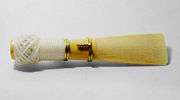Double reed
A double reed is a type of reed used to produce sound in various wind instruments. The term double reed comes from the fact that there are two pieces of cane vibrating against each other.[1] A single reed consists of one piece of cane which vibrates against a mouthpiece made of metal, hardened rubber, resin, or some other material. The term double reeds can also refer collectively to the class of instruments which use double reeds.
Construction

There are several differences, the most obvious being size, between various types of double reeds, for example between that for a bassoon and that for an oboe or a cor anglais (sometimes called an English horn).
Arundo donax cane is used for the making of double reeds. For bassoon reeds, tubes of this cane are first split lengthwise then gouged to a certain thickness. The chosen piece of cane is then cut to shape and the centre portion is thinned (profiled). The cane is folded end to end to form the two blades of the reed. The unprofiled end of the cane is shaped into a tube with the aid of a mandrel and bound with three (or four in some reed making techniques) strategically placed wires. A turban made out of thread is added on the third wire. It provides a hand hold for the reed that isn't a sharp wire. The folded tip is cut off to allow the blades to vibrate and final adjustments to the interior of the reed using a reamer, and to the exterior using a reed-scraping knife, are carried out. The reed is then ready to fit to the bocal of the bassoon. Note that there are many schools of thought and processes for making reeds.
The construction of double reeds for the oboe family of instruments is similar in principle: like the bassoon's reeds, they consist of two pieces of Arundo donax cane fastened together with an opening at the tip. However, because the oboe does not have a bocal, the cane must be fastened to a metal tube (the staple), the lower half of which is normally surrounded by a piece of cork. The staple is then inserted into the farrow at the upper end of the oboe.[2]
There are many different methods of making reeds and many variations of design have been developed. Players can buy reeds either ready-made, or in various stages of formation, such as part-scraped, reed blanks, or buy the staples and cane separately. Cane is sold in several forms: as tubes, gouged, gouged and shaped, or gouged and shaped and profiled. Bassoon cane has the further option of being profiled before purchase. Cane from several different regions is used in reed making, traditionally from southern France. There are also many options with regard to staples, shaping equipment, and so forth, which all have a subtle effect on the tone quality a reed will produce.
Playing a double reed


Oboe double reeds are about 7 mm in width. Bassoon double reeds are wider than oboe double reeds with a width anywhere from 13.5-15.9 mm. They are also shorter and thus do not need such a tight embouchure in order to make a sound. Most double reeds require a similar embouchure. Players must pull their lips over their teeth to protect the reed from their teeth.
List of instruments which use double reeds
Main Western orchestral instruments
Period instruments
Instruments where the reed is fully enclosed in a windcap
Instruments where the reed is partially enclosed by a pirouette
Instruments where the reed is fully exposed
Other instruments
- aulos
- bagpipes
- bombard
- duduk
- dulzaina
- guan
- gyaling
- hichiriki
- hojok
- kèn
- nadaswaram
- organ
- piffero
- pi nai (used in piphat)
- piri
- shehnai
- sralai
- sopila
- suona
- surnay
- tangmuri
- tarogato (early)
- tenora
- tible
Double reed societies
References
- ↑ Petrie, Matthew. "What Type of Reed Does an Oboe Use?". Crook and Staple. Retrieved 14 February 2015.
A double reed has two pieces of cane (Arundo Donax) that are attached to each other and vibrate against each other, when blowen, to create a sound.
- ↑ Wikisource:1911 Encyclopædia Britannica/Reed Instruments
External links
 Schlesinger, Kathleen (1911). "Reed Instruments". In Chisholm, Hugh. Encyclopædia Britannica. 22 (11th ed.). Cambridge University Press.
Schlesinger, Kathleen (1911). "Reed Instruments". In Chisholm, Hugh. Encyclopædia Britannica. 22 (11th ed.). Cambridge University Press.